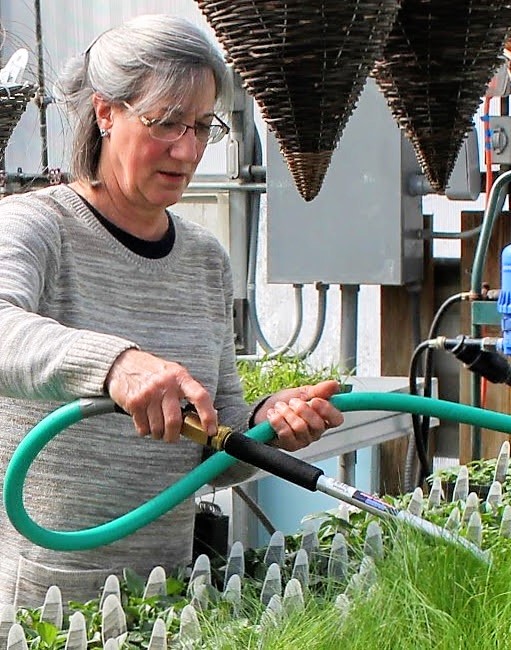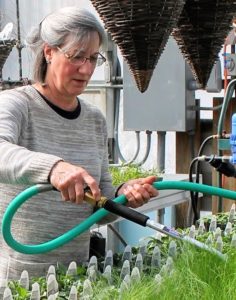
Consider Seed Starting to Expand Your Vegetable Garden Choices
Berkshire Botanical Garden’s senior gardener and propagator Christine Caccamo recommends starting seeds in a “soilless” mix that is a blend of sphagnum peat, perlite, vermiculite and limestone.
By Thomas Christopher
There are plenty of practical reasons for starting garden plants from seed. It saves you money. A packet of seeds, which can fill a whole bed with flowers or vegetables, costs no more than one or two transplants purchased ready-grown from the garden center. What’s more, starting from seed opens up a whole new world of choices. Seed catalogs offer dozens, often hundreds, of alternatives for each type of plant, many times more than you’ll find at the nearest retail outlet. When I’m looking for tomatoes that will fruit well on my cool and cloudy Berkshire hilltop, for example, I can’t find such plants ready-grown, but I do find a number of recommended cultivars in mail-order catalogs. Likewise, if I’m hankering for peppers with an authentic Southwestern flavor, or a green-flowered zinnia to add a different note to the cutting garden, chances are I’ll have to purchase them as seed.
As important as all these practical reasons, for me at least, is the sheer magic of the process. Watching the green shoots poke up from the seed-starting medium, then nurturing them into ready-to-transplant seedlings, is the distillation of springtime.
To brush up on my seed-starting technique, I recently consulted Christine Caccamo, senior gardener and propagator at the Berkshire Botanical Garden. She grows annual flowers, vegetables and herbs from seed, raising in all some 7,000 seedlings every spring.
Christine recommends sowing seeds into a special medium designed for that purpose. What she uses is a so-called “soilless mix” that is a blend of sphagnum peat, perlite, vermiculite and limestone that she buys ready-made from a greenhouse supplier; the home gardener will find the equivalent bagged and ready to go on the shelves of any good garden center. Such soil-less mixes are free from the kind of fungi that inhabit regular garden soil and that can attack seedlings, stunting or killing them. To prevent disease transmission Christine also advocates using new containers for seed starting or old ones that have been thoroughly cleaned – I wash mine and sterilize them in a solution of Lysol and water.
Be sure, Christine says, to time your sowings properly, as starting seeds too early is a leading cause of crop failure. The information you will need you’ll find, generally, on the seed packet. Typically, it will tell you how many weeks before the last spring frost you should sow the seeds. There are websites online which, if you type in your zip code, will tell you what the date of the last frost is in your area, and then you count backward from that. I work this out with an agenda book I get for this purpose every spring, and when I’ve noted the appropriate date for the sowing, I can enter other information about the seed: how the packet recommends sowing the seed, whether they should be buried or left exposed on the surface of the seed-starting medium, and how many days, on average, the seeds will need to germinate.
Christine sows her seeds in plastic trays that measure 4 in. by 6 in. and 2 in. deep, and then transplants the strongest ones to cell packs, giving each one an individual cell, when the seedlings have grown their second pair of true leaves.
Grow the seedlings under artificial lights; this produces stronger, healthier plants than a window sill. Christine recommends fluorescent lights, alternating “cool white” tubes with “warm white” and hanging the light fixtures on chains so that you can keep the light source a couple of inches above the seedlings as they grow.
How you water is important. You need to moisten the seed-starting mixture without water-logging it. Christine suggests watering from the bottom, setting your seed and seedling containers in a shallow tray of water and letting the moisture wick up through the medium. This moistens the medium thoroughly without wetting the seedlings’ stems and leaves, which can promote diseases.
If you’ve sown in a soilless mix, the seedlings will also need fertilization. I use a balanced, soluble fertilizer diluted to half the recommended concentration and apply it twice as often as called for on the label
Keep records, Christine urges, of what types of seeds you sowed, how you treated them after sowing, and how they performed, both indoors and later in the garden. If you do, you’ll know which are worth repeating the next spring. Because having experienced seed-starting once, you’ll be sure to want to try it again.
Thomas Christopher is the co-author of “Garden Revolution” (Timber Press, 2016) and is a volunteer at Berkshire Botanical Garden. berkshirebotanical.org
Be-a-Better-Gardener is a community service of Berkshire Botanical Garden, one of the nation’s oldest botanical gardens in Stockbridge, MA. Its mission to provide knowledge of gardening and the environment through 25 display gardens and a diverse range of classes informs and inspires thousands of students and visitors on horticultural topics every year. Thomas Christopher is the co-author of Garden Revolution (Timber press, 2016) and is a volunteer at Berkshire Botanical Garden. berkshirebotanical.org.



